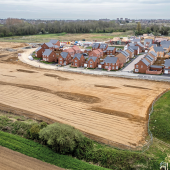New regulations for higher-risk buildings ready for parliamentary scrutiny

The government laid new legislation before the Houses of Parliament recently with the intention of establishing a more stringent building safety regime for higher-risk buildings.
The Higher-Risk Buildings (Key Building Information etc.)(England) Regulations 2023 form an important part of the reforms the Department of Levelling Up, Housing and Communities (DLUHC) is pushing forward under the Building Safety Act 2022 and introduce new legal requirements for the principal accountable person, the individual responsible for the repair of the structure and exterior of higher-risk residential buildings.
Importantly, the regulations also clarify the parts of a higher-risk building for which accountable persons are responsible in situations when there are multiple accountable persons involved in its ownership.
The proposed legislation contains provisions that are designed to improve the management of fire and structural safety risks in England’s higher-risk buildings and is a response to the recommendations made in Dame Judith Hackitt’s Building a Safer Future report, to ensure the lessons from the Grenfell Tower fire have been properly learned so that another tragedy doesn’t happen in the future.
Dame Judith’s report highlighted significant flaws in the existing building safety system, including major issues relating to ‘the transparency of information, and inadequate audit trails of information through the life cycle of a building’. Her report noted that these flaws failed to ‘provide reassurance and evidence that a building has been built to be safe and continued to be safe’.
In response to her recommendations to create a more robust safety regime for higher-risk buildings, the proposed legislation requires the principal accountable person to provide the Building Safety Regulator with high level information about the building to inform decisions.
Regulations 3 to 18 outline the specific information required, which includes details about the potential risk factors such as use, change of use, the external wall system, the structural design type of the building, the number of storeys and staircases, energy supplies, the evacuation strategy for the building, and whether it is attached to any other building.
As the Explanatory Memorandum to the new regulations explains, the purpose of providing this critical information is so that the Building Safety Regulator can undertake ‘an initial triage of the potential risk levels’ for the 13,000 buildings in England that meet the detailed specifications of ‘higher-risk’ as defined by the Building Safety Act 2022 and the Higher-Risk Buildings (Descriptions and Supplementary Provisions) Regulations 2023, which were put before Parliament on 19 December 2022 and are still subject to parliamentary approval.
‘The [Building Safety] Regulator will require building assessment certificate applications as a priority for the buildings where, based on the information provided and other sources of intelligence from other regulators, the regulator assesses the building’s potential for a building safety risk materialising to be higher than others,’ the memorandum explains.
The DLUHC also expects the information provided will support the Building Safety Regulator in its oversight of higher-risk buildings. The government departments adds that the intention is for the regulator to use this important information to monitor trends across these buildings in England and consider whether any further action is required to resolve any of the risks identified.
In addition, the information provided will enable the Building Safety Regulator to prioritise the assessment of the fire and structural safety in existing high-rise residential buildings and identify similar buildings or systems if an issue emerges.
The proposed legislation places a requirement on the principal accountable person of a higher-risk building, or a person authorised to act on their behalf, to submit the information in an electronic format that the Building Safety Regulator will specify.
Importantly, the principal accountable person will be required to provide this information within 28 days of submitting an application for registration of the higher-risk building. In addition, they must also notify the Building Safety Regulator of any change to the high-level information within 28 days of them becoming aware of the change.
‘Residential building ownership is not always straightforward’, the DLUHC points out, ‘with multiple accountable persons having entered complex lease arrangements dictating the repairing responsibilities of different parts of the buildings’.
Therefore, another intention of these new regulations is to enable those involved in the building safety management of a higher-risk building to identify which accountable person is responsible for a particular part of a building in relation to their responsibilities under the Building Safety Act 2022.
The proposed legislation explains that if there is more than one accountable person for a building, then each one will be responsible for providing the principal accountable with information to submit to the Building Safety Regulator.
As the government department notes, the new legislative proposal is the second set of regulations governing the new building safety regime, following the Higher-Risk Buildings (Descriptions and Supplementary Provisions) Regulations 2023, and further legislation will follow in the future.
A DLUHC spokesperson said that the key building information will enable the Building Safety Regulator to both analyse and understand the risks, so they can prioritise the assessment of existing higher-risk buildings.
‘We have worked with the Health and Safety Executive and other stakeholders to ensure the key building information can meet these objectives and is proportionate,’ they said.
‘We consulted on the key building information requirements last year, and the majority of respondents were in favour of the proposals.’








